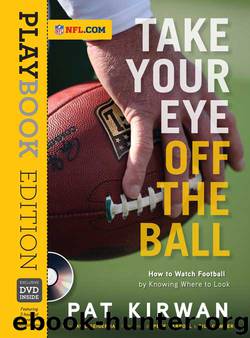Take Your Eye Off the Ball by Pat Kirwan & David Seigerman

Author:Pat Kirwan & David Seigerman [Kirwan, Pat & Seigerman, David]
Language: eng
Format: epub
Publisher: Triumph Books LLC
Published: 2012-08-29T05:00:00+00:00
The most critical decision Mike Tomlin made along the road that would eventually lead the Pittsburgh Steelers to another Super Bowl championship was his first one.
Tomlin was hired to be Pittsburgh’s head coach in January 2007 after serving as the defensive coordinator in Minnesota. Under Tomlin, the Vikings had the NFL’s best run defense in 2006.
Earlier in the decade, Tomlin was the defensive backs coach in Tampa Bay. The Bucs had the league’s top-rated defense in both 2002 and 2005, the high point being a victory in Super Bowl XXXVII when they intercepted five passes and returned three of them for touchdowns.
And so a man who cut his coaching teeth in the heyday of the Tampa 2 defense and its 4-3 front moved to another team and built another dominant defense, also with a 4-3 front. Still, when he was hired to replace Bill Cowher in Pittsburgh, he concluded that switching away from the 3-4 front that the Steelers had played under Cowher for more than a decade wouldn’t work. The roster he inherited was built for a 3-4 system, and converting to the 4-3 he was more familiar with—and probably preferred—would’ve destroyed what the Steelers had built and might have set the defense back at least a couple of seasons.
Tomlin’s decision to stay in a 3-4 was one a lot of coaches wouldn’t have been able to make, primarily because of their egos. But it was the right call, as the Steelers’ sixth Lombardi Trophy confirmed.
A lot of fans wonder, What’s the real difference? 3+4 and 4+3 both equal 7, right?
Well, not exactly.
In fact, the identities of the two defensive fronts are entirely different—from the philosophy driving them to the personnel needed to play each system.
Job Descriptions: 3-4
Not long ago, there were only a handful of teams in the NFL operating out of a 3-4 front (three down linemen and four linebackers). But just as Bill Walsh’s West Coast offense spread across the league in the wake of San Francisco’s success, the 3-4 is becoming increasingly popular as coaches watched Bill Parcells (its prime architect), the Patriots, and the Steelers stock their trophy cases.
By the start of the 2010 season, 15 teams were operating a 3-4 scheme. There were more 3-4 defenses in the AFC (10) than 4-3 defenses (six).
With more players standing up in a two-point stance, 3-4 defenses can adapt to the exotic offenses they’re seeing more and more of, and they’re better equipped to handle a quarterback in the shotgun with an empty backfield. Since only three defenders are playing with their hand on the ground, a 3-4 team can send pressure from anywhere. As Tim Ryan, my partner on Movin’ the Chains, says, “The offense doesn’t know who’s coming or where they’re coming from.” It confuses offensive linemen trying to identify their protection responsibilities.
The difference between the two systems starts right up front. The job of the defensive line in a 3-4 is not to penetrate into the backfield; it’s to occupy as much of the offensive line as possible, freeing the linebackers to make plays.
Download
This site does not store any files on its server. We only index and link to content provided by other sites. Please contact the content providers to delete copyright contents if any and email us, we'll remove relevant links or contents immediately.
Relentless: A Memoir by Julian Edelman(1755)
Cristiano Ronaldo: The Biography by Guillem Balague(1468)
The Source by James A. Michener(1459)
ALEX FERGUSON My Autobiography by Alex Ferguson(1440)
1942 by Winston Groom(1404)
Football's Strangest Matches by Andrew Ward(1398)
When Pride Still Mattered by Maraniss David(1304)
Time's Champion by Time's Champion (Craig Hinton & Chris McKeon)(1214)
Chiefs by Stuart Woods(1211)
Where Men Win Glory: The Odyssey of Pat Tillman by Jon Krakauer(1141)
Gunslinger by Jeff Pearlman(1130)
0.721 by Gary Webster(1111)
Paterno by Joe Posnanski(1080)
Snake by Mike Freeman(1048)
Coming Back Stronger by Drew Brees & Drew Brees(1045)
Texas Monthly On… by Texas Monthly(1037)
League of Denial by Mark Fainaru-Wada(1014)
Deal Breaker by Harlan Coben(1009)
It Takes What It Takes by Trevor Moawad(985)
